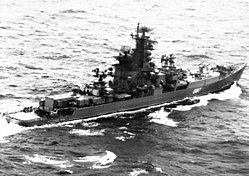Kresta I class
|
Project 1134 cruiser Wize-Admiral Drosd , 1986
|
||||||||||||||
|
||||||||||||||
|
||||||||||||||
|
||||||||||||||
|
||||||||||||||
Project 1134 Berkut , designated by NATO as the Kresta-I-class , was a class of four guided missile cruisers of the Soviet and later the Russian navy .
history
At the beginning of the 1960s, the Soviet Navy commissioned the development of a new, powerful class of cruisers that could be used primarily against submarines. This was in response to the development of the Polaris-A-1 submarine-based ICBM , which was being tested in the United States at the time. The American submarines now became an even greater threat, which required strong anti-submarine capabilities. The Soviet cruisers of the Kynda class, which were put into service in the 1960s, were designed for surface targets and therefore did not have enough anti-submarine weapons. This led to the development of the Kresta I class, which was designed primarily for fighting submarines, but also had powerful anti-ship missiles . A few years later, the Kresta II class was put into service, which was equipped with even higher anti-submarine capabilities, but lost the anti-ship armament.
construction
Armament
On both sides of the bridge, the ships of the Kresta I class were each equipped with a double starter for anti-ship missiles of the P-35 type (NATO code: SS-N-3 Shaddock). The missiles achieve a range of 460 km and can optionally be equipped with an 800 kg shaped charge warhead or a 100 kt nuclear warhead.
Two double starters for the naval version of the Issajew S-125 Neva (NATO code: SA-3-Goa) were installed for air defense . One starter was located on the deck in front of the bridge, the second, viewed from the stern, was located behind the helicopter hangar. The associated missiles have a range of 10 km, with the modernized variant ranges of around 25 km are achieved. The missiles can be used either against air or sea targets. The ships of the Kresta I class could be equipped with up to 44 of these missiles.
The Kresta-I-class was also equipped with two twin guns of the type AK-725 . The guns have a caliber of 57 mm, a range of about 8.5 kilometers and a cadence of 200 rounds / min. However, they are practically ineffective against approaching missiles. It is unclear whether they can be used effectively against aircraft. They were located on both sides of the superstructure of the rear half of the ship.
For anti-submarine defense, two twelve - tube depth bomb launchers of the type RBU-6000 were installed on the bow, two six-tube depth charges of the type RBU-1000 on both sides of the helicopter hangar and two five-tube torpedo launchers . The RBU-6000 have a range of 6,000 m and a caliber of 213 mm. The associated projectiles weigh 110 kg, the warhead weighs 25 kg. Submarines can thus be fought at a depth of 10 to 500 m. The RBU-1000 have a range of 1,000 m and a caliber of 300 mm. The projectile weight is 195 kg and the warhead has a weight of 95 kg.
Half of the four ships of this class - the Vize-Admiral Drosd and the Admiral Sosulja - were also retrofitted with four six-barrel Gatling guns of the AK-630 type . These were located on both sides of the superstructure in the middle of the ship.
Dimensions and drive
The ships of the Kresta I class were 156 m long, 17 m wide and had a draft of approx. 6 m. They had a standard displacement of approx. 6100 t and a fully loaded approx. 7500 t. The ships were powered by two steam turbines with a total of around 91,000 WPS on two shafts. This enabled top speeds of up to 34 knots to be achieved. The range was around 10,400 nautical miles at an ideal speed of 14 knots and around 5,000 nautical miles at 18 knots.
units
All four units in the class have now been decommissioned and scrapped. Three of them were decommissioned in the Soviet Union . A ship, Wize-Admiral Drosd (Russian: Вице-адмирал Дрозд) sank in 1992 on the way to dismantling.
The last ship Admiral Sosulja (Russian: Адмирал Зозуля), was the end of 1994 in the port of Baltiysk decommissioned and scrapped 1995th
| Surname | Name Russian | Keel laying | Commissioning | Decommissioning | Scrapping |
|---|---|---|---|---|---|
| Wize-Admiral Drosd | Вице-адмирал Дрозд | 1965 | 1968 | 1990 | Sunk in 1992 on the way to dismantling |
| Vladivostok | Владивосток | 1964 | 1969 | 1990 | 1995 |
| Sevastopol | Севастополь | 1966 | 1969 | 1990 | 1991 |
| Admiral Sosulja | Адмирал Зозуля | 1965 | 1969 | 1994 | 1995 |
literature
- С.С. Бережной: Советский ВМФ 1945–1995 Крейсера - большие противолодочные корабли, эсминцы. (For example: SS Bereschnoi: Soviet Navy 1945–1995. Cruisers, large submarine fighters, destroyers. ) Moscow 1995.
Web links
- Kresta I class ( Memento from 23 August 2006 in the Internet Archive ) on fas.org (English)
- Kresta I class on janes.com (English)
- Kresta I class on ship.bsu.by (Russian)
